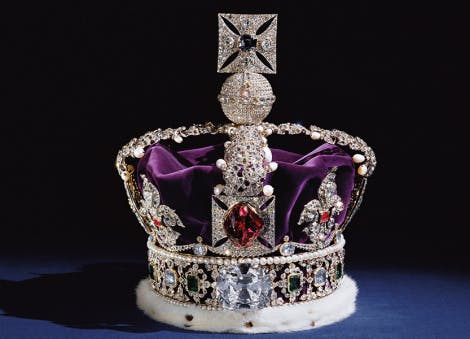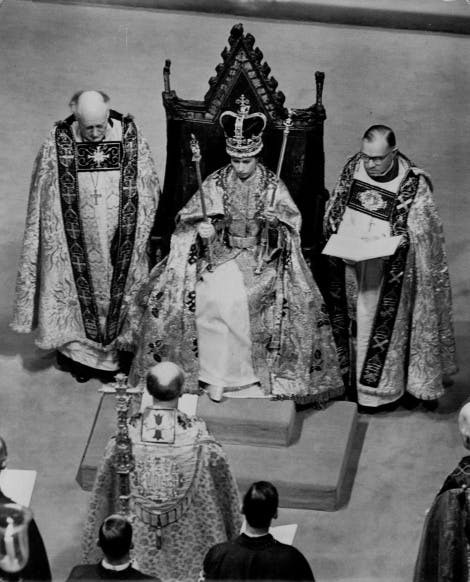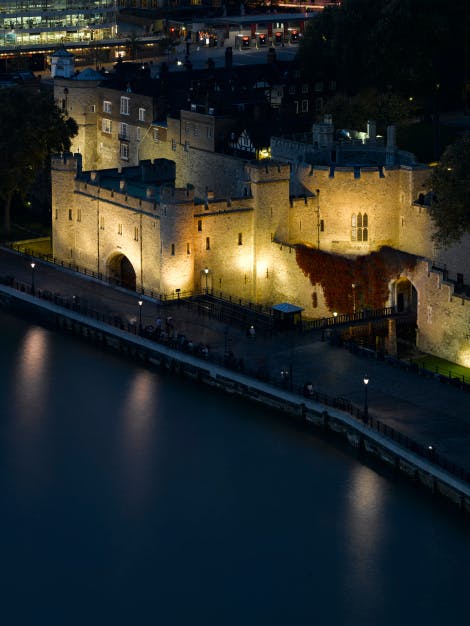Tower of London to unveil new display in its Jewel House, sharing the history of the world-famous Crown Jewels in the Coronation year
Opens 26 May 2023
The new Jewel House exhibition is made possible thanks to the generosity of Garrard.
It has been the home of the Crown Jewels for nearly 400 years, protecting these priceless objects, steeped in history. Now, in May 2023, the Tower of London is set to transform its Jewel House, with a new display exploring more stories than ever before about the history and significance of the Crown Jewels. The display will open just weeks after the world has witnessed the Coronation of His Majesty The King and Her Majesty The Queen Consort.
The Crown Jewels, part of the Royal Collection, are powerful symbols of the British Monarchy and hold deep religious, historic, and cultural significance. The new display will be the first major change to the Jewel House at the Tower of London for over a decade. A new exhibition, leading towards the Treasury where most of the Crown Jewels are kept, will explore the origins of some of the objects for the first time, including the destruction of the original jewels under Oliver Cromwell. The display will evoke the spectacle and pageantry of the Coronation procession and Service.
The re-presentation is the culmination of a major four-year project for Historic Royal Palaces – the independent charity that cares for the Tower of London – which set out to delve deeper into the history of both the collection and of Coronations in the Jewel House. It will begin with a celebration of the timelessness of monarchy, displaying the State Crown frames worn by past monarchs George I, George IV, and Queen Victoria and explaining how many of the most historic jewels – including the famous ‘Black Prince’s Ruby’ - have passed from crown to crown.
The exhibition will then explore the origins of the current Crown Jewels, starting with the destruction of the medieval Coronation Regalia in 1649, during the English Civil War. A Commonwealth coin from the era on loan from the British Museum will go on display, demonstrating how the melted gold once worn by medieval monarchs was re-used in the inter-regnum. The Coronation Regalia we see today was recreated for the Coronation of King Charles II: only the Coronation Spoon survives as a relic of the earlier medieval collection. The collection has been added to by succeeding monarchs ever since – most recently in 2020 with the addition of the 1969 Investiture Coronet for the then Prince of Wales - and the new display will follow the evolution of the collection through time.
The history of the Koh-i-Noor, which is set within the Crown of Queen Elizabeth the Queen Mother, will be explored. A combination of objects and visual projections will explain the stone’s story as a symbol of conquest, with many previous owners, including Mughal Emperors, Shahs of Iran, Emirs of Afghanistan, and Sikh Maharajas. The story of the famous Cullinan diamond will also feature, with the hammer and knife used to make the first cuts to the huge diamond going on display in the Jewel House for the first time. Discovered in South Africa in 1905, the diamond is the largest gem-quality uncut diamond ever found at 3106 carats. It was split into nine major stones and 96 smaller brilliants, with the largest two stones featuring in the Sovereign’s Sceptre with Cross and the Imperial State Crown.
At the heart of the new display will be a room dedicated to the spectacle, pageantry and community of the Coronation Procession. The display will present Coronation Processions throughout history, celebrating the contributions of the many people who take part in these unique events. On display will be a series of objects from the Royal Ceremonial Dress Collection, including an exquisite court suit worn at the Coronation of George IV and a herald’s tabard which would have been worn during royal processions.
The display will culminate in the Treasury, the vault that protects most of the Crown Jewels collection, comprising over 100 objects in total. Among the spectacular items on display in the Treasury is St Edward’s Crown of 1661, which is used at the moment of crowning and is the most important and sacred crown within the collection. The Sovereign’s Sceptre with Cross and the Sovereign’s Orb, which are presented to the monarch during the moment of investiture, are also on display in the Treasury. New lighting will allow visitors to experience the world-famous collection like never before.
The display will open shortly after the world has witnessed the Coronation of Their Majesties The King and The Queen Consort. The Tower of London has seen many Coronations in its long history. For centuries, it was tradition for the monarch to stay at the Tower two nights before the Coronation before processing to Westminster, accompanied by a display of pomp and pageantry. The last Coronation procession from the Tower took place in 1661 for Charles II, but the Crown Jewels have been housed within the Tower’s walls ever since. In 2022, they were visited by over 2 million people and it is anticipated that people from around the world will visit the Jewel House in 2023.
Andrew Jackson, Resident Governor of the Tower of London and Keeper of the Jewel House, said, “We are delighted to unveil our brand-new Jewel House display from 26 May, offering visitors a richer understanding of this magnificent collection. As the home of the Crown Jewels, we are delighted that the Tower of London will continue to play its part during this historic Coronation year. We look forward to expanding the stories we are telling about the Crown Jewels, and to showcasing this remarkable collection for millions of visitors from around the world to enjoy.”
Charles Farris, Public Historian for the History of the Monarchy at Historic Royal Palaces, said, “The Crown Jewels are the most powerful symbols of the British Monarchy and hold deep religious, historic, and cultural significance. From their fascinating origins to their use during the Coronation ceremony, the new Jewel House transformation will present the rich history of this magnificent collection with more depth and detail than ever before. With 2023 bringing the first Coronation in 70 years, there has never been a better time for people to come and learn about the jewels and to appreciate these awe-inspiring objects in person.”
The new Jewel House exhibition opens to visitors on 26 May 2023 and is included in general admission.
Notes to editors
For further information and images please contact the Historic Royal Palaces Press Office via press@hrp.org.uk / 020 3166 6166
Tickets: Adults: £33.60 / Children: £16.80 / Concessions: £26.80 / Members go free
Please note that the Treasury will remain open before the 26 May, although as a working collection, some items will be off display for periods of time ahead of the Coronation.
The commonwealth coin on display in the Jewel House is on loan from Trustees of the British Museum.
Historic Royal Palaces is a team of people who love and look after six of the most wonderful palaces in the world. We create space for spirits to stir and be stirred. We want everyone to feel welcome and accepted. We tell stories about the monarchs you know and the lives you don’t. We let people explore and we set minds racing. We are a charity and your support gives the palaces a future, for everyone.
Registered charity number 1068852. For more information visit www.hrp.org.uk
The Royal Collection is among the largest and most important art collections in the world, and one of the last great European royal collections to remain intact. It comprises almost all aspects of the fine and decorative arts, and is spread among some 15 royal residences and former residences across the UK, most of which are regularly open to the public. The Royal Collection is held in trust by the Sovereign for his successors and the nation, and is not owned by The King as a private individual. Royal Collection Trust, a department of the Royal Household, is responsible for the care of the Royal Collection and manages the public opening of the official residences of The King.
About Garrard
Set in the heart of London since 1735, Garrard’s royal legacy lives on in its exceptional handcrafted jewels.
Since being appointed the first official Crown Jeweller in 1843, Garrard has proudly played its part in British royal history, creating jewels that have captured imaginations throughout the world. From the legendary setting of the Cullinan I diamond, the world’s largest cut and colourless diamond, to glittering tiaras worn at state occasions and Princess Diana’s iconic engagement ring, Garrard has crafted some of the most famous jewels of all time.
After almost 300 years, the House’s industry-leading designers, gemmologists and craftspeople continue to be entrusted with extraordinary new designs for royalty and private clients, alongside the exquisite jewels in Garrard’s collections, each of which bears the quintessential British hallmarks of heritage and handcraftsmanship.
With its future continuing to unfold, great jewellery traditions are being written anew at Garrard in designs that move the heart and empower the soul – now, and forever.
Browse more history and stories

The Crown Jewels
The history of the Crown Jewels, including the Imperial State Crown - a priceless collection used to crown the kings and queens of England.

Coronations Past and Present
An ancient ceremony, largely unchanged for a thousand years

The story of the Tower of London
Iconic fortress, royal palace and infamous prison
